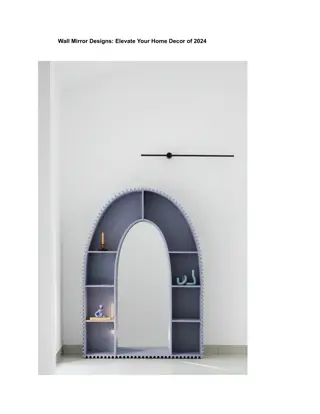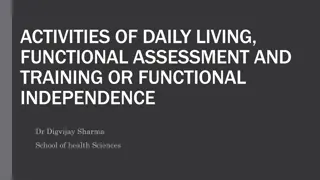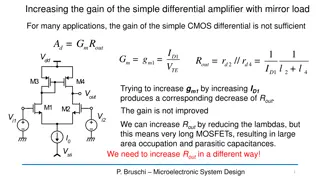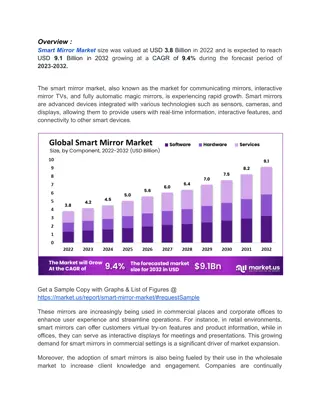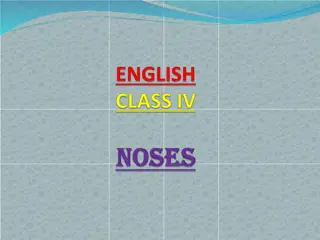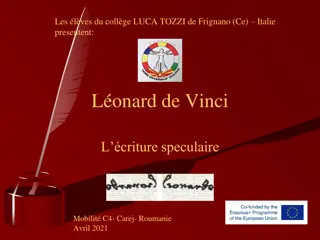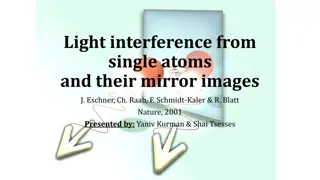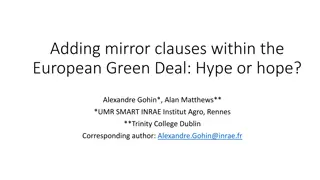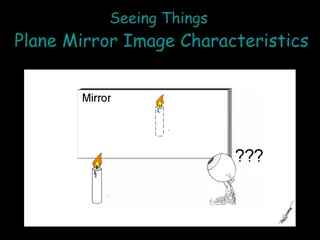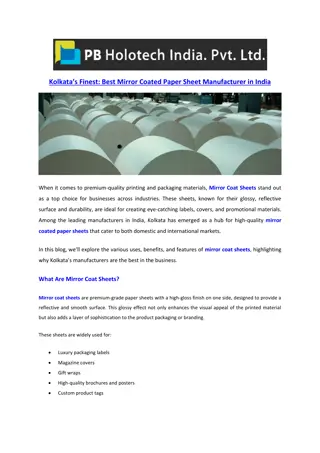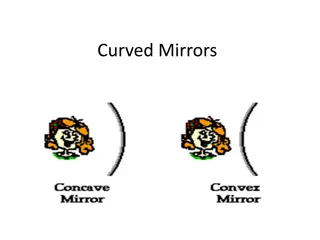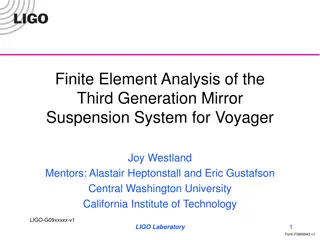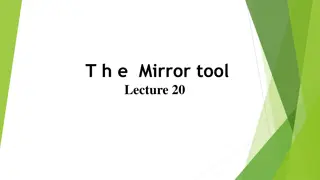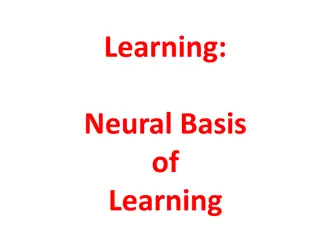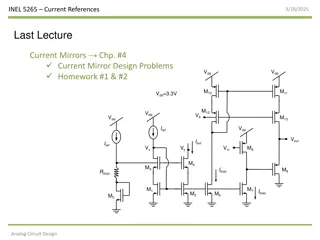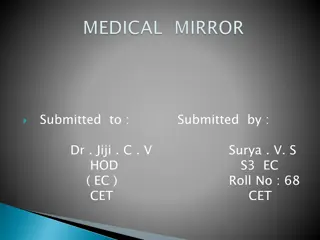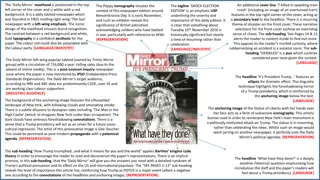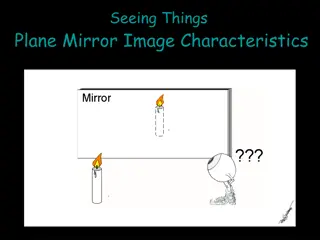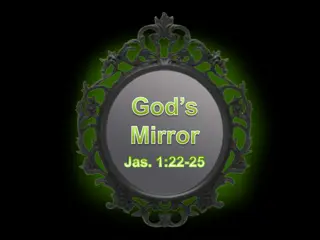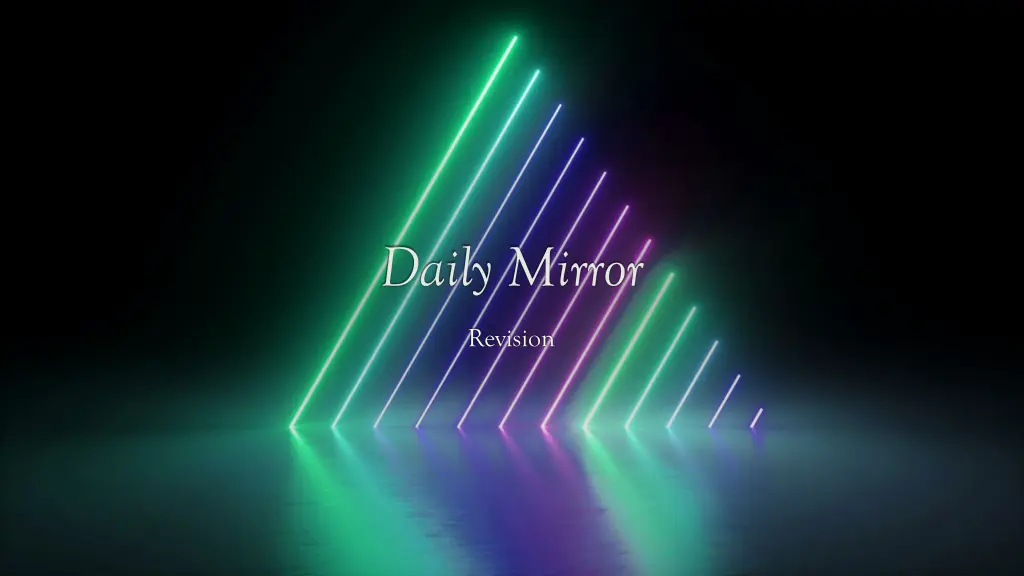
Facts and Insights about Daily Mirror: 1903 Establishment, Trinity Mirror, and Media Language
Discover key facts about the Daily Mirror, including its founding year in 1903, ownership by Trinity Mirror, and insights into tabloid media language. Learn about the bold layouts and popular content strategies used by tabloids, along with a glimpse into the Brexit political context. Stay informed with this comprehensive examination of media language and the Daily Mirror's cultural impact.
Download Presentation

Please find below an Image/Link to download the presentation.
The content on the website is provided AS IS for your information and personal use only. It may not be sold, licensed, or shared on other websites without obtaining consent from the author. If you encounter any issues during the download, it is possible that the publisher has removed the file from their server.
You are allowed to download the files provided on this website for personal or commercial use, subject to the condition that they are used lawfully. All files are the property of their respective owners.
The content on the website is provided AS IS for your information and personal use only. It may not be sold, licensed, or shared on other websites without obtaining consent from the author.
E N D
Presentation Transcript
Daily Mirror Revision
Section A Key facts about Daily Mirror What year was the newspaper first produced? - 1903 How much does it cost? - 45p Who is Trinity Mirror? - A British newspaper, magazine and digital publisher. Who else do they own? - The Daily Mirror, the Sunday Mirror, the Sunday People, the Sunday Mail and local titles including the Liverpool Echo and the Manchester Evening News. What is the company s mission statement? - The company states in its 'Vision and Values': 'Our vision is to be essential part of people's daily lives by delivering quality content and services that inform, enlighten and enrich
Media language The codes and convention of Tabloids consist of elements which promotes popularity over story content. There are several ways that this is done, they can do this by the use of bold layouts. Having a bold layout means that they will include dramatic pictures, colourful mastheads and is easy to read. The mode of address is informal, to be comical and often addresses the reader to punctuate the information as important.
Media language Front page Strapline fighting for you provides solidary for people confused or worried about the political turmoil of Brexit. Theresa May in a small image looking serious, anchors the headline, the image being tiny, reinforces how little respect or faith the Mirror has in her abilities. The Cheltenham Festival pull-out dominates the page, with bright green font and background, combined with an exciting action shot of a horse and a rider, grabbing the attention rather than the political story. The article about the assault on the actor is a close-up of her upset face, to create empathy and the reader feel closer to this character , the humanising the story teased by the jump line to appropriate page inside.
Media language Double page spread Medium shot of Theresa May her hands are raised which could connote defeat or exasperation at her predicament. The text of the article shows it is a mixture of all of these. May is portrayed as someone who is losing, but who is losing, but is also bravely fighting on against the odds. The language of the whole article is allegorical; portraying the debate in parliament as if it is a horse race. A Faller At The 2nd is racing track slang for poorly performing horse.
Political context On 23rdJune 1016, citizens of UK voted to leave the EU. This was called Brexit. Th vote was 51.9% to leave and 48.1% voting remain. The controversies from the campaign continued even after the vote. Remainers accused leave voters of xenophobia and racism; leavers accused remainers of being unpatriotic and un-democratic. The period since the referendum has been on of political turmoil. Following the resignation of David Cameron shortly after the vote, Theresa May has faced regular leadership challenges from within her own party, and a snap general election in 2017 in which her party suffered heavy losses. On the date this edition of the Mirror was published, MPs had voted against the deal she had negotiated with the EU. This was very serious as the UK was scheduled to be leaving the EU just ten days after
Cultural context Eastenders is one of the UK s most popular soap operas, with a reputation for featuring hard-hitting storylines that often feature issues such as rape, domestic violence and homophobia. Since 1985, it has been regularly watched by audiences of up to 20 million people. This has turned the actors into celebrities and - like Dyer s Star Theory suggests - tabloid newspapers often run stories about the actor s lives mirroring their Eastenders storylines. Traditionally, one of the Mirror s (and other tabloids ) main elements is sports reporting - often over half the paper is dedicated to sport. The back pages often feature the betting odds for horse races and will have special pull out features when there is a major racing event. Racing meets like Ascot and Cheltenham have upper class associations but have increasingly become popular days out for the less wealthy audiences.
Representation By reducing Theresa May to the smallest image on the page, the Mirror is sending a clear message about the way she is seen by her fellow MPs and by the newspaper s target audience. The headline focuses on her defeat and implies the whole situation is her fault - there is very little description of the MPs who have challenged her. The small amount of space given to the whole story - along with the ...Loses Key Vote Again headline - suggests that, these political conflicts have become almost commonplace, and this is all part of the ongoing Brexit chaos .
Theoretical approaches Feminist theory Van Zoonen Van Zoonen suggested that women are often portrayed as sexualised, weak or vulnerable in the media. Though the two women featured on the Mirror s cover are from stories that seem to portray them as vulnerable, the images used connote strength and defiance in the face of adversity; also neither are sexualized. Structuralism Levi Strauss There is a binary opposition between the MPs and the Nation which feeds into the us vs them ideology of populism . There is also an opposition between the two political pundits on the double page piece. The language in the headlines (plus the odds from Honest Jason ) also explains some quite complex political debates in using the allegory of a horse race - this dramatises the details
Theoretical approaches Post modernism - Jean Baudrillard Presence of simularcra / irony / hyper reality in the ongoing portrayal of the disastrous negotiations over a no deal Brexit for the UK, since the vote was originally cast under David Cameron. The fact that the negotiations themselves have become something of an ongoing joke amongst certain media formats (in particular news media). Openly pastiches / parodied in satirical current affairs TV programmes such as Have I Got News for You, Mock the Week, etc. and recreated in TV Dramas such as Brexit: The Uncivil War (starring Benedict Cumberbatch).
Section B History The Daily Mirror was first published in 1903 as a newspaper for women to act as a mirror on feminine life . However, the newspaper was quickly redesigned to appeal to a broader middle class audience. It was founded by Alfred Harmsworth, who sold it to his brother Harold Harmsworth in 1913. In 1963 a restructing of the media interests of the Harmsworth family led to the Mirror becoming a part of International Publishing Corporation. It s sister paper, the Sunday Mirror began in 1915, starting as the Sunday Pictorial and becoming the Sunday Mirror in 1963.
Industry context The Daily Mirror often employs intertextuality and popular cultural images / references to better establish a connection to its largely mainstream working class readership, often repackaged as parody or pastiche. It assumes that it s audience are media savvy and are well versed in aspects of popular culture enough to recognise irony and sarcasm and often uses references to these other texts to exploit its own political and social agenda. For example, the Brexit edition, the small cut-out image of a MCU of Theresa May looking perplexed / disappointed is used to separate the larger bolder headline and the main copy of the article this image coupled with the over line of the red text stating PM loses key vote again , the headline word Mayhem and the kay words of the Sub heading, surrenders and massive defeat combine to frame May s leadership in an extremely incompetent light, thus positioning the audience firmly on the side of the pollical left.
Audiences producers target audiences The Daily Mirror s target audience, according to NRS and ABC data is predominantly C2DE, over 35 and are working class Labour supporters. Readers of the Daily Mirror have a relatively low reading age (typical of red top tabloid readership), hence the reliance of simple terms and restricted code language / low register within stories. Slightly more female orientated newspaper(perhaps a reflection of the target readership of the Mirror when it was first released in 1903?) as reflected by the female friendly content of many stories (celebrity gossip, fashion, reality TV, etc.) A larger readership in the north of the UK, reflected in its left wing, Labour supporting, working class politics.
Audiences audience interpretation Specifically within the Brexit Front Page & Centre Page Spread, the audience is positioned as being disapproving of May, a Tory PM, and towards the other MPs. The use of despairing, defeated language would resonate with their cynicism towards politicians, and their fears about the chaos of Brexit. The red font and central positioning of the headline indicates that this story is important but the sandwiching between adverts for gambling, along with the Loses Again indicates this s just another instalment in a long, tedious process, and it is advisable to focus on more entertaining experiences.
Reflecting context The tone of the Brexit article and the prominence of more stereotypical working class entertainment like soap operas and horse racing link to ideology of populism that has become more prevalent in mainstream politics over the past 5 years. Donald Trump s Make America Great Again and Nigel Farage s attack on the elite encourage the view that mainstream politicians are hopelessly out of touch with the common people
Newspapers = tailor made Front pages: image focused. Lots of pictures to interest the protentional reader. Massive headlines (Which can fill up most of the page) and only a small section of the larger story (will use jump line to tell reader where to find the rest). Emphasis on puff to elaborate offers / promotions within. Back pages: One major sporting headline with smaller secondary story down the side or top / bottom of page. Emphasis on the large picture and massive headline to stress emphasis. Letters page: Celebrity and Television orientated. Comments of no real substance , only reflect attitude and opinion which largely supports the Daily Mirror s underlying ideologies.
Online = Tailor made Home page: Bright, colourful and containing massive images (all linked to story when clicked o(pics and headings). Home page is scrolling list of the days most important stories smaller stories (pics and headings) are either older or less important. Menu system in operation along header (across all pages) offering simple alternatives (News, Politics, etc.) along with social media icons. Celeb pages: same layout as home page (large images, smaller headings all linked to stories when clicked), large emphasis on reality TV celebs, sex and nudity.
Theoretical approaches End of audience Clay Shirky The concept of audience members as passive consumers is no longer tenable in the age of the internet with the rise of the prosumer who can create their own content such as submitting stories and being part of forums. Newspapers like The Guardian have embraced this, taking popular below-the-line (i.e. non-professional) commentators and offering them above-the-line columns. The Mirror does offer some opportunities for citizen journalism (e.g. the What s Your Story? section of their website) the majority of content is still written by journalists.
Theoretical approaches Cultivation theory Gerbner Audience exposure to repeated patterns of representation (of May, of Brexit, or of modern politics) by newspapers may shape and influence their views and opinions. Gerbner went on to say that this is not like hypodermic model but rather depends on what the audience already believes. The messages (e.g. politicians are ineffectual) need to resonate with an established belief (e.g. Brexit is a chaotic mess) in the audience (e.g. working class, left-wing men and women). Reception theory Stuart Hall There is an ambiguous representation of women on the front page. Some may decode the stories as portraying women as defeated and vulnerable; others may negotiate a meaning as these women being defiant in the face of adversity.
Theoretical approaches Power and media industries Curran and Seaton Reach plc has maintained their position in the UK market despite falling sales of the Mirror and other mainstream titles by diversifying into regional news. This diverse pattern of ownership has allowed them to create the conditions for more varied and adventurous media products. Regulation Sonia Livingstone and Peter Lunt. Reach plc is facing increasing pressure alongside the rest of the UK press industry to adhere to strict rules and regulations on industry practice. This has arisen after the phone hacking scandal and subsequent Leveson enquiry into the industry. There is an underlying issue of protecting citizens from harmful material while ensuring choice and press freedom.

